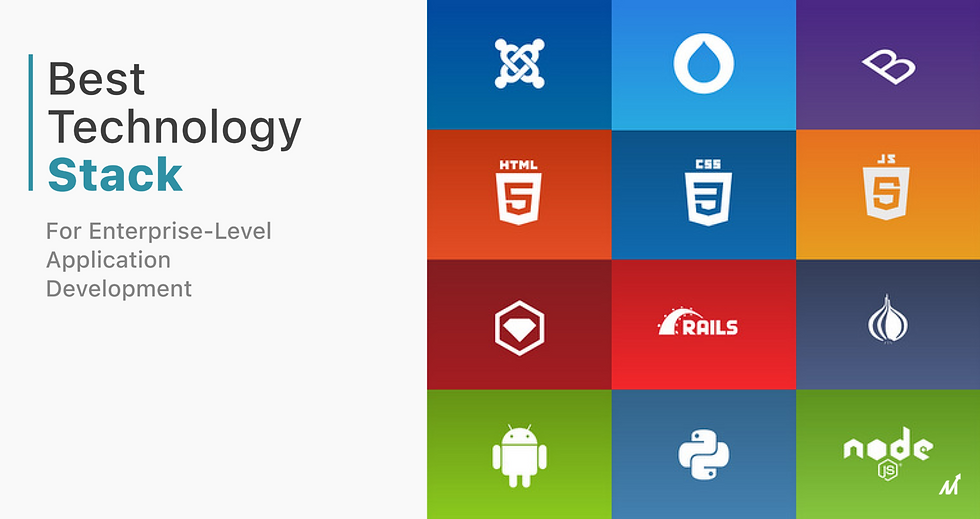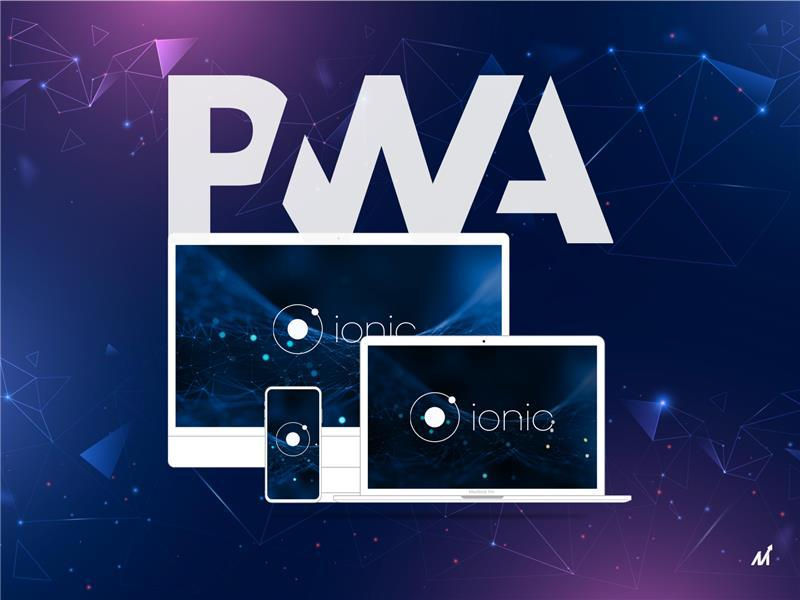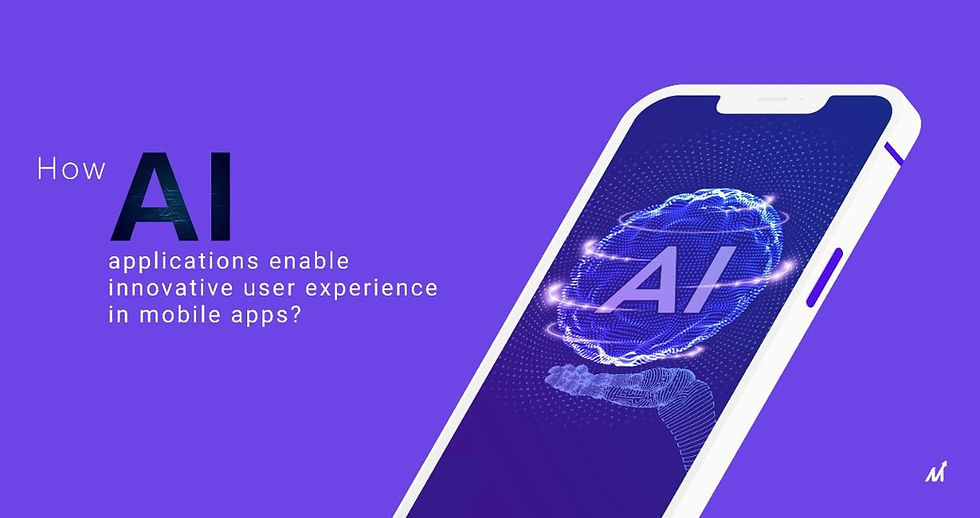The Best Technology Stack For Enterprise-level Application Development
- amit9154
- Mar 10, 2022
- 9 min read

A few of the most frequently asked queries regarding tech stacks we typically encounter are:
Which technology stack is the best to utilize for enterprise application development?
What is the best technology stack to meet your specific requirements of your business?
What are the most important elements to take into consideration before deciding on one particular technology stack over the others?
We've addressed each of these questions in this blog that will aid you in understanding the details of selecting the right tech stack to build an enterprise-level application.
Let's get started!
What is a tech stack ? the development of enterprise applications?
Tech stacks are essentially an assortment of programming languages, software tools, databases, frameworks front-end and back-end tools, and apps that are connected through APIs.
They are used for the development of enterprise applications and create digital products such as mobile applications, web-based apps, and websites. Also, it is referred to as the solution stack.
In essence, it's an entire ecosystem of programs, data, and tools that are combined to build and manage a digital service.
Developers or product engineers can access a variety of tech stacks and tools to build and maintain their products. Therefore, selecting different frameworks to ensure a solid enterprise application development is feasible.
With the right technology stack Your company can get an application that is tailored to your specific business needs and demands.
It is crucial to choose the appropriate tech stack for your business application.
If you are developing an application for your business selecting the right technology stack is essential to get the most effective outcomes for the application you want to build. You must choose from various technologies before arriving at the right combination of frameworks to build websites, applications software, etc.
A carefully planned and thought-out decision about the best choice for your technology stack will ensure seamless operation of your enterprise application. In essence, it will determine the type of software you'll be able to create.
Because developers are experts in a variety of technologies, this will affect the type of developer you should hire. Additionally, with each tech stack, there are advantages and disadvantages. For instance, certain tech stacks provide advanced customizations and others offer lots of enhancements, etc.
Be sure to speak with experts in the field and define your needs, so that you are able to select the right tech stack.
Let's break down the elements of a tech stack , so that you can understand their importance in the development of apps.
Technologies stack components for the development of enterprise applications
Two of the main elements through the development of any app are:
The customer (frontend) and
The servers (backend).
Furthermore Each of these components is made up of layers that are used for development of enterprise applications. They are constructed over each other and form an array.
The image below demonstrates the way tech stacks are designed for both client and server-side.
Let's look at what is the frontend stack and the backend stack and backend stack, respectively:
Tech stack for front-ends
Frontend technology stacks are the client side of every application. Frontend , also known as client-side, refers to the content that users are able to see in their screen. It is basically where they are able to interact, or view in the app. Its primary function is to provide a powerful interaction with the user, including user interface, and internal structure. It is accountable for the design, format and navigation of an application.
The three major components of the front-end technology stack are as the following:
HTML (the markup language)
A markup language that generates websites and shows them as electronic documents. Its primary function is organizing and the placement of content on the web page.
CSS (Cascading Style Sheets)
CSS has the responsibility for the formatting and layout of the web pages. CSS is responsible for the layout and format of web pages.
It covers sizes, font styles layout, color and other elments of a website page that are used to help develop enterprise applications. Frameworks such as SASS (Syntactically Awesome Style Sheets)and LESS(Large-Scale Scrum) help to make CSS easier to manage and more dynamic.
JavaScript (the programming language)
JavaScript is a programming language. JavaScript is utilized to create interactive web pages. It lets you implement dynamic elements on websites. It is possible to implement JavaScript using standard frameworks and libraries like jQuery, React, Angular, and Vue.
A lot of modern applications currently make use of TypeScript instead of basic JavaScript. Since, in contrast to JavaScript it allows you to avoid errors and other changes for developers.
Tech stack for backend
The backend is the server side for enterprise development. The server-side, or the backend is the part that is invisible to the final user.
It also ensures the proper operation of all features and components. It is responsible for the logic of the application. It serves as the foundation of applications and websites. Imagine it as the electric power stations that function as a backbone for providing power to your home.
The backend is comprised of frameworks that allow the application to run built on a single programming language.
Thus, the frameworks, programming languages and technology, servers, databases are constructed on top of each the other to create an backend technology stack.
Django, Ruby On Rails, Laravel are some of the most popular frameworks used for the backend tech stacks.
There is no need to pick frameworks starting from scratch. We've listed and outlined some of the most popular and well-known technology stacks for enterprise development of applications. The tech stacks listed below could be a great start point for your enterprise development process.
Popular tech stacks that are used to develop enterprise applications:
MEAN
MEAN Stack is an open-source JavaScript software stack which can be used to create dynamic enterprise applications and websites. It comes with these frameworks MongoDB, Express.js, Angular JS (or Angular) and the Node.js.
It is a well-known tech stack for companies who wish to develop apps in a short time. With MEAN Stack, JavaScript is utilized for the development of server-side and client-side applications. Meaning, it is an end-to-end JavaScript Stack.
Furthermore, MEAN makes the development of applications simple to code for developers , and the process of transitioning much simpler.
A few variations of MEAN include MEEN-MongoDB Express.js, Ember.js, and Node.js.
MERN
MERN stack is very identical to MEAN however, the only difference is of the fact that MERN's framework Angular.js is replaced with React.js.
React.js offers MERN with a robust library source for make up the MEAN stack. It is able to implement code simultaneously across browsers and servers, and full-stack development.
The programming languages utilized in the framework React.js include: JavaScript XML and Virtual DOM that allows for an easy implementation of any changes.
React.js is a framework that is well-known for its versatility, speed and the ability to create apps with an interactive user interface. It also comes with an extensive range of tools to test,
The technology stack MERN is an open source and has an extremely strong community support. It is among the most well-known tech stacks to build single-page apps that have an interactive user interface.
.NET
.NET is a strong and battle-tested frameworkthat is exclusively designed to build dynamic applications.
It is the .NET stack is part of the Overflow Stack, which is an extensive tech stack that has the capability to meet the needs of any developer.
In conjunction with other open technology when combined with other open source technologies, the .NET stack allows the creation of small-scale apps as well for enterprise-level applications that have numerous capabilities.
The frameworks are comprised of 60 and platforms within the .NET stack, which includes the CLI (Common Language Infrastructure) languages that are spread across 13 layers.
ROR
The Rubyon Rails (ROR) stack is a great choice for rapid app development because of its speedy integration capabilities.
The framework is extremely adaptable, it is based on the ActiveRecord pattern, and works in conjunction with MySQL on the backend.
In Ruby on Rails it is possible to can access a database built-in and an extensive collection of open-source code. It's easy to modify and can save lots of time.
Flutter
Flutter is among the stacks of technology that have revolutionized the industry of cross-platforms.
A few of the components of Flutter are the Flutter engine, Dart platform, Foundation Library, and specific widgets for design.
With Flutter, you are able to create applications for the Web, iOS, Android, Mac, Windows, and Linux using a single source code base as well as business-logic.
The most appealing aspect of Flutter application development is that there's no compromise in speed when creating user interfaces, adding features and fixing bugs, for example.
Flutter is among the most powerful frameworks for app development in 2022 to support hybrid app development.
We have a thorough analysis of Ionic and. Flutter. Read this .
When choosing one of these tools and frameworks within a stack of tech, it is important to ensure that they are compatible both in the front and backend. This can help reduce development time as well as helping coordinate resources. It is also crucial to have a consistent, standard, and reliable tech stack.
Many factors need to be taken into consideration when choosing the right tech stack. They are discussed in the following section.
What is the best technology stack for your business solution?
The most important and asked question is 'How do you select the right tech platform for an enterprise solution What is the best tech stack for your enterprise?
Start by asking your developers which framework best suits your application's requirements and requirements?
Your application isn't an individual deployment, but rather an array of components and services that can be deployed in different programming languages.
To make it easier for you to go about selecting the best tech stack for your business application development, we've identified the most important factors to take into consideration when choosing the right tech stack to develop your next app:
The kind of application development
The kind of product or app development will determine how you select your technology stack.
If your application needs to be completed in a shorter time, development will be more straightforward and will include alternatives with built-in features and templates. Frameworks such as Ruby or Node.js help speed up development of apps and are suitable for this type of development.
If the app development process requires the use of more time and puts priority on quality, you will require the use of a mix of frameworks and technologies that could take longer time, but concentrate on seamless functionality and integration. With enough time to develop on various platforms, you can have the ability to select different levels of frameworks and technologies. .NET stack and its vast capabilities would be a good choice in this scenario.
Scalability
In the case of a tech stack, two kinds of scalability available are horizontal and vertical scaling.
Vertical scalability refers to how simple it is to incorporate new features with a specific technology stack.
Horizontal scalability refers to the amount of technology stacks can scale to accommodate the growth of users.
The ideal technology stack must meet both kinds of scaling.
Frameworks such as Flutter as well as the ROR tech stacks can, for instance, allow the creation of applications that can be highly adaptable.
Expertise
The experience of your team's developers determines the selection of the tech stack to build your enterprise application.
The development team is responsible for making decisions, analyzing and deploying the most effective technology and frameworks to run your business. Your developers must be able to utilize all layers of your tech stack to fully developing your enterprise application. Tech stacks that are more complex require developers with more experience and expertise.
A skilled team of developers can provide innovative solutions to address issues that arise in the development of apps. Also, it will help you adopt a method of development that is strategic by conducting tests. To ensure that quality is guaranteed in every module of your app development for enterprise.
Maintenance
When developing an app the app should be able to manage and maintain. The tech stack you choose to use will determines how easy it will be to manage your application.
For instance, if your codes are longer and longer, they will take longer time to process and then manage. Repairing bugs should be a lot easier also if your development method is well-planned and simple to manage.
Making codebases that are easy to maintain by using frameworks and a tech stacks will guarantee an effortless development of your app.
Development costs
The price of your app development is also an important factor to consider when it comes to selecting the right tech stack.
Although the majority of tech stacks are available as open-source , for more advanced capabilities and features, you need purchase the licensed version. Tech stacks come with varying cost based on hosting charges and technology licensing fees, costs of developers.
The analysis of your budget and the best choice of technology stack is a crucial step. It is important to consider built-in features and high-end features. Compare them in light of your requirements for the project and budget in order to select the most suitable technology stack to develop your enterprise applications.
If you're outsourcing the development of your app, selecting the right software vendor and a company for product development is crucial. With the correct tech stack, your app will be built more easily and update and evolve to meet the changing needs of your customers.
As a company for product development our team of experts employs a systematic approach to develop robust applications that are designed to meet specific project requirements and specifications using the most modern and current technologies. We focus on key elements such as the conceptualization, ideation, and assessment, MVP development, features improvement, product launches and branding.







Comments